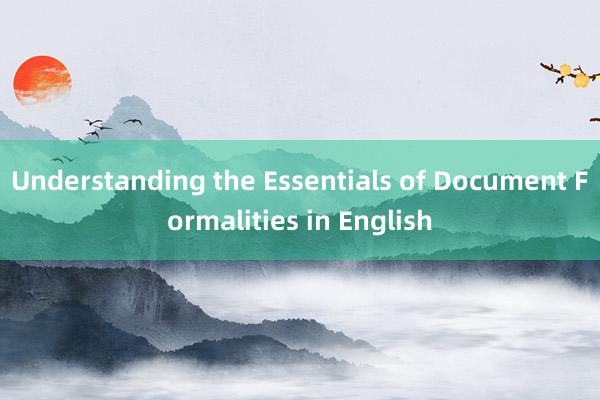
### Understanding the Essentials of Document Formalities in English
In today's globalized world, understanding document formalities in English is crucial for effective communication across various professional and personal contexts. Whether you're drafting contracts, filling out legal forms, or engaging in academic research, mastering the essentials of document formalities in English can significantly enhance your ability to convey information accurately and professionally. This article aims to provide an overview of key aspects that one should consider when dealing with documents in English.
#### 1. **Greeting and Salutation**
- **Formal**: When addressing someone formally, it's essential to use appropriate salutations. For instance, "Dear Mr./Ms. [Last Name]," is a standard way to start a letter or email. It shows respect and formality.
- **Casual**: In more relaxed settings, such as emails within a company where a good rapport exists, using first names might be acceptable, but always check if the person prefers this.
#### 2. **Introduction**
- **Purpose**: Clearly state the purpose of the document at the beginning. This helps the reader understand the context and the main points quickly.
- **Context**: Provide enough background information so that the reader can comprehend why the document is being presented and its relevance.
#### 3. **Body of the Document**
- **Structure**: Organize the body logically. Typically, 春城种业 this involves presenting the main arguments, 福建台帆实业有限公司 providing evidence,低碳车网站 and explaining the rationale behind decisions or actions.
- **Clarity and Conciseness**: Use clear, concise language. Avoid jargon unless it is common knowledge for the intended audience. If specialized terms must be used,企业-裕明威粮食有限公司 ensure they are defined or explained.
#### 4. **Conclusion**
- **Summary**: Recap the main points discussed in the document to reinforce the argument or proposal.
- **Call to Action**: Depending on the document, conclude with a request for action, confirmation, or further discussion.
#### 5. **Closing**
- **Formal**: Conclude with a formal closing, such as "Sincerely," followed by your name.
- **Casual**: In informal settings, a simple "Best regards," or "Cheers," might suffice.
#### 6. **Proofreading**
- **Grammar and Spelling**: Ensure there are no grammatical errors or spelling mistakes. Tools like Grammarly or Microsoft Word’s spell checker can be very helpful.
- **Consistency**: Maintain consistency in style and tone throughout the document.
#### 7. **Signature**
- **Electronic Documents**: For digital signatures, ensure they are legally valid and securely attached to the document.
- **Physical Documents**: Signatures are crucial in legal documents to authenticate their validity. Always sign clearly and legibly.
#### 8. **Attachments**
百盛新药特药- **Relevance**: Only include attachments that are necessary for the document's purpose. Ensure they are labeled appropriately and easily accessible.
Understanding these essentials can help you craft documents that are not only professional but also effectively communicate your intentions and ideas. Whether you're dealing with business communications, academic papers, or legal agreements, adhering to these guidelines will enhance clarity企业-裕明威粮食有限公司, professionalism, and the overall impact of your written work in English.